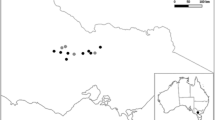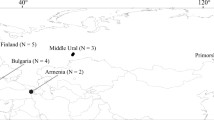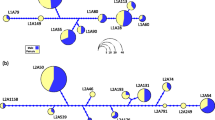Abstract
The mutational mechanism underlying the striking diversity in MHC (major histocompatibility complex) genes in vertebrates is still controversial. In order to evaluate the role of inter- and intragenic recombination in MHC gene diversification, we examined patterns of nucleotide polymorphism across an exon/intron boundary in a sample of 31 MHC class IIB sequences of three-spined stickleback (Gasterosteus aculeatus). MHC class IIB genes of G. aculeatus were previously shown to be under diversifying (positive) selection in mate choice and pathogen selection experiments. Based on recoding of alignment gaps, complete intron 2 sequences were grouped into three clusters using maximum-parsimony analysis. Two of these groups had >90% bootstrap support and were tentatively assigned single locus status. Intron nucleotide diversity within and among loci was low (p-distance within and among groups = 0.016 and 0.019, respectively) and fourfold lower than the rate of silent mutations in exon 2, suggesting that noncoding regions are homogenized by frequent interlocus recombination. A substitution analysis using GENECONV revealed as many intergenic conversion events as intragenic ones. Recombination between loci may explain the occurrence of sequence variants that are particularly divergent, as is the case in three-spined stickleback, with nucleotide diversity attaining dN = 0.39 (peptide-binding residues only). For both MHC class II loci we also estimated the amount of intragenic recombination as population rate (4Ner) under the coalescent and found it to be approximately three times higher compared to point mutations (Watterson estimate per gene, 4N e μ). Nonindependence of molecular evolution across loci and frequent recombination suggest that MHC class II genes of bony fish may follow different evolutionary dynamics than those of mammals. Our finding of widespread recombination suggests that phylogenies of MHC genes should not be based on coding segments but rather on noncoding introns.


Similar content being viewed by others
References
Bergström TF, Josefsson A, Erlich HA, Gyllenstein U (1998) Recent origin of HLA–DRB1 alleles and implication for human evolution. Nat Genet 18:237–242
Binz T, Reusch TBH, Wedekind C, Milinski M (2001) SSCP analysis of Mhc class IIB genes in the threespine stickleback. J Fish Biol 58:887–890
Bradley RD, Hillis DM (1997) Recombinant DNA sequences generated by PCR amplification. Mol Biol Evol 14:592–593
Britten RJ, Rowen L, Williams J, Cameron RA (2003) Majority of divergence between closely related DNA samples is due to indels. Proc Natl Acad Sci USA 100:4661–4665
Brown CJ, Garner EC, Dunker AK, Joyce P (2001) The power to detect recombination using the coalescent. Mol Biol Evol 18:1421–1424
Brown JH, Jardetzky TS, Gorga JC, Stern LJ, Urban RG, Strominger JL, Wiley DC (1993) Three-dimensional structure of the human class II histocompatibility antigen HLA-DR1. Nature 364:33–39
Doherty PC, Zinkernagel RM (1975) Enhanced immunological surveillance in mice heterozygous at the H-2 complex. Nature 256:50–52
Edwards SE, Wakeland EK, Potts WK (1995) Contrasting histories of avian and mammalian Mhc genes revealed by class II B sequences from songbirds. Proc Natl Acad Sci USA 92:12200–12204
Elsner HA, Rozas J, Blasczyk R (2002) The nature of introns 4–7 largely reflect the lineage specificity of HLA-A alleles. Immunogenetics 54:447–462
Fearnhead P, Donnelly P (2001) Estimating recombination rates from population genetic data. Genetics 159:1299–1318
Figueroa F, Mayer WE, Sültmann H, O’hUigin C, Tichy H, Satta Y, Takezaki N, Takahata N, Klein J (2000) Mhc class II B gene evolution in East African cichlid fish. Immunogenetics 51:556–575
Gu X, Nei M (1999) Locus specificity of polymorphic alleles and evolution by a birth-and-death process in mammalian MHC genes. Mol Biol Evol 16:147–156
Hess CM, Edwards SV (2002) The evolution of the major histocompatibility complex in birds. Biosience 52:423–431
Högstrand K, Böhme J (1994) A determination of the frequency of gene conversion in unmanipulated mouse sperm. Proc Natl Acad Sci USA 91:9921–9925
Hudson RR (2001) Two-locus sampling distributions and their application. Genetics 159:1805–1817
Hudson RR, Kaplan NL (1985) Statistical properties of the number of recombination events in the history of a sample of DNA sequences. Genetics 111:147–164
Hughes AL (1999) Adaptive evolution of genes and genomes. Oxford University Press, New York
Hughes AL (2000) Evolution of introns and exons of class II major histocompatibility comples genes of vertebrates. Immunogenetics 51:473–486
Hughes AL, Nei M (1988) Pattern of nucleotide substitution at major histocompatibility complex class I loci suggests overdominant selection. Nature 335:167–170
Klein J (1986) Natural history of the major histocompatibility complex. Wiley & Sons, New York
Kreitman M, Hudson RR (1991) Inferring the evolutionary histories of the adh and adh-dup loci in Drosophila melanogaster from patterns of polymorphism and divergence. Genetics 127:565–582
Kriener K, O’hUigin C, Tichy H, Klein J (2000) Convergent evolution of major histocompatibility complex molecules in humans and New World monkeys. Immunogenetics 51:169–178
Kumar S, Tamura K, Nei M (2004) MEGA version 3: Integrated software for Molecular Evolutionary Genetics Analysis and sequence alignment. Brief Bioinform 5:150–163
Kupfermann H, Mayer WE, O’hUigin C, Klein D, Klein j (1992) Shared polymorphism between gorilla and human histocompatibility complex DRB loci. Hum Immunol 34:267–278
Langefors Å, Lohm J, Grahn M, Andersen Ø, von Schantz T (2001a) Association between major histocompatibility complex class IIB alleles and resistance to Aeromonas salmonicida in Atlantic salmon. Proc R Soc Lond Ser B 268:479–485
Langefors Å, Lohm J, von Schantz T (2001b) Allelic polymorphism in MHC class II B in four populations of Atlantic salmon (Salmo salar). Immunogenetics 53:329–336
Lee MSY (2001) Unalignable sequences and molecular evolution. Trends Ecol Evol 16:681–685
Malaga-Trillo E, Zaleska-Rutczynska Z, McAndrew B, Vincek V, Figueroa F, Sültmann H, Klein J (1998) Linkage relationships and haplotype polymorphism among cichlid Mhc class II B loci. Genetics 149:1527–1537
Martinsohn JT, Sousa AB, Guethlein LA, Howard JC (1999) The gene conversion hypothesis of MHC evolution: a review. Immunogenetics 50:168–200
McVean G, Awadalla P, Fearnhead P (2002) A coalescent-based approach for detecting and estimating recombination from gene sequences. Genetics 160:1231–1241
Nei M, Gojobori T (1986) Simple methods for estimating the numbers of synonymous and nonsynonymous nucleotide substitutions. Mol Biol Evol 3:418–426
Nei M, Hughes AL (1992) Balanced polymorphism and evolution by the birth-and-death process in the MHC loci. In: Tsuji K, Aizawa M, Sasazuki T (eds) 11th Histocompatibility Workshop and Conference. Oxford University Press, New York, pp 27–38
Nei M, Li W-H (1980) Non-random association between electromorphs and inversion chromosomes in finite populations. Genet Res 35:65–83
Ohta T (1999) Effect of gene conversion on polymorphic patterns at major histocompatibility complex loci. Immunol Rev 167:319–325
Orti G, Bell MA, Reimchen TE, Meyer A (1994) Global survey of mitochondrial DNA sequences in the threespine stickleback: evidence for recent migrations. Evolution 48:608–622
Parham P, Ohta T (1996) Population biology of antigen presentation by MHC class I molecules. Science 272:67–74
Penn DJ, Damjanovich K, Potts WK (2002) MHC heterozygosity confers a selective advantage against multiple strain infections. Proc Natl Acad Sci USA 99:11260–11264
Posada D (2002) Evaluation of methods for detecting recombination from DNA sequences: empirical data. Mol Biol Evol 19:708–717
Potts WK, Manning CJ, Wakeland EK (1991) Mating patterns in seminatural populations of mice influenced by MHC genotype. Nature 352:619–621
Reusch TBH, Häberli MA, Aeschlimann PB, Milinski M (2001a) Female sticklebacks count alleles in a strategy of sexual selection explaining MHC polymorphism. Nature 414:300–302
Reusch TBH, Wegner KM, Kalbe M (2001b) Rapid genetic divergence in postglacial populations of threespine stickleback (Gasterosteus aculeatus): the role of habitat type, drainage, and geographical proximity. Mol Ecol 10:2435–2445
Reusch TBH, Schaschl H, Wegner KM (2004) Recent duplication and inter-locus gene conversion in major histocompatibility class II-genes in a teleost, the three-spined stickleback. Immunogenetics 56:427–437
Richman AD, Herrera LG, Nash D (2001) MHC class II beta sequence diversity in the deer mouse (Peromyscus maniculatus): implications for models of balancing selection. Mol Ecol 10:2765–2773
Richman AD, Herrera LG, Nash D, Schierup MH (2003) Relative roles of mutation and recombination in generating allelic polymorphism at an MHC class II locus in Peromyscus maniculatus. Genet Res Cambridge 82:89–99
Rozas J, Sanchez–DelBarrio JC, Messeguer X, Rozas R (2003) DnaSP version 4: An integrated program for molecular population genetics and molecular evolution analysis. Bioinformatics 19:2496–2497
Sato A, Figueroa F, O’Huigin C, Steck N, Klein J (1998) Cloning of major histocompatibility complex (MHC) genes from threespine stickleback, Gasterosteus aculeatus. Mol Mar Biol Biotechnol 7:221–231
Sato A, Mayer WE, Tichy H, Grant PR, Grant BR, Klein J (2001) Evolution of Mhc class II B genes in Darwin’s finches and their closest relatives: birth of a new gene. Immunogenetics 53:792–801
Satta Y, O’Huigin C, Takahata N, Klein J (1993) The synonymous substitution rate of the major histocompatibility complex loci in primates. Proc Natl Acad Sci USA 90:7480–7484
Sawyer, SA (1999) Geneconv: a computer package for statistical detection of gene conversion. Code available at http://www.math.wustl.edu/∼sawyer
Stet RJM, Kruiswijk CP, Dixon B (2003) Major histocompatibility lineages and immune gene function in fish: the road not taken. Crit Rev Immunol 23:441–471
Strohbeck C (1983) Expected linkage disequilibrium for a neutral locus linked to a chromosomal arrangement. Genetics 103:545–555
Stumpf MPH, McVean GAT (2003). Estimating recombination rates from population-genetic data. Nat Rev Genet 4:959–968
Takahata N, Nei M. (1990) Allelic genealogy under frequency-dependent selection and polymorphism of major histocompatibility complex loci. Genetics 124:967–978
Wakeland EK, Boehme S, She JX, Lu CC, McIndoe RA, Cheng I, Ye Y, Potts WK (1990) Ancestral polymorphism of MHC class II genes: divergent allele advantage. Immunol Res 9:115–122
Watterson GA (1975) On the number of segregating sites in genetical models without recombination. Theor Pop Biol 7:256–276
Wegner KM, Kalbe M, Kurtz J, Reusch TBH, Milinski M (2003a) Parasite selection for immunogenetic optimality. Science 301:1343
Wegner KM, Reusch TBH, Kalbe M (2003b) Multiple parasite species are driving major histocompatibility complex polymorphism in the wild. J Evol Biol 16:224–232
Westerdahl H, Wittzell H, von Schantz T (2000) Mhc diversity in two passerine birds: no evidence for a minimal essential MHC. Immunogenetics 52:92–100
Wiehe T, Mountain J, Parham P, Slatkin M (2000) Distinguishing recombination and intragenic gene conversion by linkage disequilibrium patterns. Genetic Res 75:61–73
Yeager M, Hughes AL (1999) Evolution of the mammalian MHC: natural selection, recombination, and convergent evolution. Immunol Rev 167:45–58
Zangenberg G, Huang M-M, Arnheim N, Erlich H (1995) New HLA-DPB1 alleles generated by interallelic gene conversion detected by analysis of sperm. Nat Genet 10:407–414
Acknowledgments
We thank H. Schaschl for many valuable comments on the manuscript, S. Carstensen, S. Liedtke, N. Ryk, C. Schmuck, and T. Sonntag for laboratory assistance, and M. Milinski for ecouragement and support. Many thanks go to T. Reimchen for providing stickleback samples from British Columbia. TBHR thanks W. T. Stam for initially introducing him to indel alignment. TBHR was supported by Deutsche Forschungsgemeinschaft (DFG Re 1108/4 and -5). AL received a fellowship from the Swedish Research Council.
Author information
Authors and Affiliations
Corresponding author
Additional information
[Reviewing Editor: Dr. Richard Kliman]
Rights and permissions
About this article
Cite this article
Reusch, T.B., Langefors, Å. Inter- and Intralocus Recombination Drive MHC Class IIB Gene Diversification in a Teleost, the Three-Spined Stickleback Gasterosteus aculeatus. J Mol Evol 61, 531–541 (2005). https://doi.org/10.1007/s00239-004-0340-0
Received:
Accepted:
Published:
Issue Date:
DOI: https://doi.org/10.1007/s00239-004-0340-0




